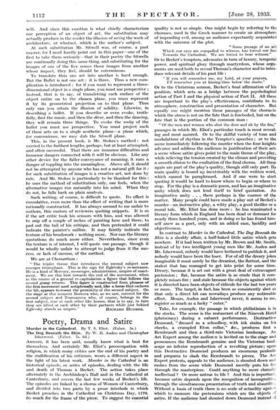The Sitwell Plane
Russian Ballets. By Adrian Stokes. (Faber and Faber. 7s. 6d.) THE time must be shortly coming when someone, searching in the past for unjustly forgotten names, will re-discover the Sitwell Family. All the auguries indicate it. In their own day, one party held their work beautiful ; while to other equally honest and earnest persons it seemed the chattering of wicked monkeys, that ought not to be allowed ; and such conflicts of opinion are frequently the parentage of fame. Since their day, to that recent generation of poets whose peculiar defence against reality was to bury their heads in a rather greenhorn sort of politics, their work seemed, naturally enough, a mere nursery tinkle. But now that generation are themselves, for the most part, a wave that is receding.
The Sitwells' poems perhaps are, or perhaps are not, read at the moment : I don't know. But it is easy for a reviewer to recognize, again and again, their influence on contemporary writing. In prose, perhaps, more commonly than poetry. It is particularly noticeable in the style of Mr. Ailrian Stokes.
One is continually reminded in this book of the technique of Mr. Sacheverell Sitwell's Southern Baroque Art. For it is characteristic of Mr. Sitwell's method that he substitutes, to an unparalleled extent, evocation for description. It is a very subtle psychological trick. It rests on this : that the images in plastic art which will evoke a certain eihotion differ from the images in literary art which will evoke the same emotion. To detail the former in words will not produce this emotion : to substitute for them the latter set of images
will. And since this emotion is what chiefly characterizes our perception of an object of art, the substitution may actually produce in the reader the illusion of seeing the work of architecture, or whatnot, which is the author's subject.
At such substitution Mr. Sitwell was, of course, a past master; for I need hardly point out in this paper—one of the first to take them seriously—that in their poetry the Sitwells are continually doing this same thing, and substituting for the images of one of the five senses those images from another Whose impact, they feel, should be coterminous.
To translate thus one art into another is hard enough. But the Ballet is not one art : it is three. Thus a new com- plication is introduced ; for if you want to represent a three- dimensional object in a single plane, you must use perspective ; instead, that is to say, of transferring each surface of the object entire on to the chosen plane, you must represent it by its geometrical projection on to that plane. Thus only can you attain the illusion of solidity. Likewise, in describing a ballet. If you describe or even evoke, truth- fully, first the music, and then the decor, and then the dancing, they will remain three things. To evoke the unity of the ballet you must use perspective. You must project each of these arts on to a single aesthetic plane—a plane which, for convenience, we may dub the Sitwell plane.
This, in the present book, is Mr. Stokes's method : not carried to the furthest lengths, perhaps, but at least attempted, and often successful. That there are immense difficulties and
immense dangers connected with it will be obvious. Like any other device for the fuller conveyance of meaning, it runs a danger of toppling into the meaningless. Above all, it should not be attempted by anyone who has not a natural gift for it : for such substitution of images is a creative act, not done by . rule. And Mr. Stokes is particularly to be thanked for this : he uses the method of substitution only, one feels, when the alternative images rise naturally into his mind. When they do not, he falls back on plain analysis.
Such writing, of course, is difficult to quote. Its effect is Cumulative, even more than the effect of writing that is more rationally constructed. It has always seemed to me unfair to authors, this custom of reviewers quoting snippets. it is as if the art critic took his scissors with him, and was allowed to snip off a couple of inches of painting here and there, to pad out the tail of his critique, and then pretended it could indicate the painter's calibre. It may faintly indicate the texture of his brushwork : nothing more. Nor can the literary quotations do much more either. NeVertheless, since even the texture is of interest, I will quote one passage, though it would be wholly unfair to attempt to judge from it the sue- eess, or lack of inccess, of the method.
We .are at Choreartium :
" The triplet theme that introduces the 'second subject now emerges triumphant. This is the sign fol. EgleVsky's re-entrance. He is a kind of Mercury, messenger, administrator, umpire of enact- ment. We see this best towards the end of the movement, when in the course of a general re-capitulation a figure that follows the second group returns. This figure is constructed from phrases of the first. movement used antiphonally and, like a horse that eschews the bit, appears to resent the proximity of the second subject. On the stage at this moment Rostova who, as we saw, entered for the second subject and Toumanova who, of course, belongs to the first subject, rear at each other like horses, that is to say, in turn they are lifted at each other by their partners while- just behind







































 Previous page
Previous page